
The Karmapa Tulku lineage of the Gyalwa Karmapa is the oldest among the major incarnating lineages of Tibetan Buddhism, established in 1110 CE by the 1st Karmapa, Düsum Khyenpa. Karmapa means “the one who carries out buddha-activity”, or “the embodiment of all the activities of the buddhas.” A total of 17 Karmapa manifestations have incarnated after their predecessors predict their own rebirths in detailed letters.
A tulku is a distinctive and significant aspect of Tibetan Buddhism, embodying the concept of enlightened beings taking corporeal forms to continue the lineage of specific teachings. The term "tulku" has its origins in the Tibetan word "sprul sku", which originally referred to an emperor or ruler taking human form on Earth, signifying a divine incarnation. Over time, this term evolved within Tibetan Buddhism to denote the corporeal existence of highly accomplished Buddhist masters whose purpose is to ensure the preservation and transmission of a particular lineage.
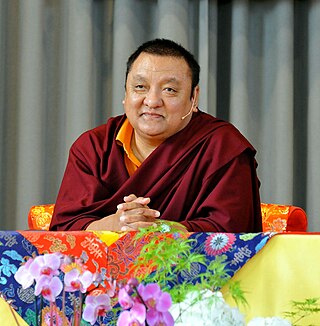
The Shamarpa, also known as Shamar Rinpoche, or more formally Künzig Shamar Rinpoche, is the second oldest lineage of tulkus. He is one of the highest lineage holders of the Karma Kagyu school of Tibetan Buddhism and is regarded as the mind manifestation of Amitābha. He is traditionally associated with Yangpachen Monastery near Lhasa.

Ole Nydahl, also known as Lama Ole, is a lama providing Mahamudra teachings in the Karma Kagyu school of Tibetan Buddhism. Since the early 1970s, Nydahl has toured the world giving lectures and meditation courses. With his wife, Hannah Nydahl (1946-2007), he founded Diamond Way Buddhism, a worldwide Karma Kagyu Buddhist organization with over 600 centers for lay practitioners.
There are currently two, separately enthroned 17th Gyalwang Karmapas: Ogyen Trinley Dorje and Trinley Thaye Dorje. The Karmapa is the spiritual leader of the nine-hundred-year-old Karma Kagyu lineage of the Kagyu school of Tibetan Buddhism.

The Rimé movement is a movement or tendency in Tibetan Buddhism which promotes non-sectarianism and universalism. Teachers from all branches of Tibetan Buddhism – Sakya, Kagyu, Nyingma, Jonang, Gelug, and Bon – have been involved in the promoting Rimé ideals.

Trinley Thaye Dorje is a claimant to the title of 17th Karmapa.

The 16th Karmapa, Rangjung Rigpe Dorje is the 16th Gyalwa Karmapa and the spiritual leader of the Karma Kagyu lineage of Tibetan Buddhism. He is of the oldest line of reincarnate lamas in Vajrayana Buddhism, known as the Karmapas whose coming was predicted by the Buddha in the Samadhiraja Sutra. The 16th Karmapa was considered to be a "living Buddha" and was deeply involved in the transmission of Tibetan Vajrayana Buddhism to Europe and North America following the Chinese invasion of Tibet. He was known as the "King of the Yogis", and is the subject of numerous books and films.
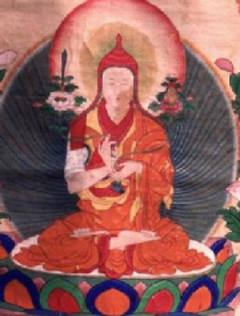
Jamgön Kongtrül Lodrö Thayé, also known as Jamgön Kongtrül the Great, was a Tibetan Buddhist scholar, poet, artist, physician, tertön and polymath. He is credited as one of the founders of the Rimé movement (non-sectarian), compiling what is known as the "Five Great Treasuries". He achieved great renown as a scholar and writer, especially among the Nyingma and Kagyu lineages and composed over 90 volumes of Buddhist writing, including his magnum opus, The Treasury of Knowledge.
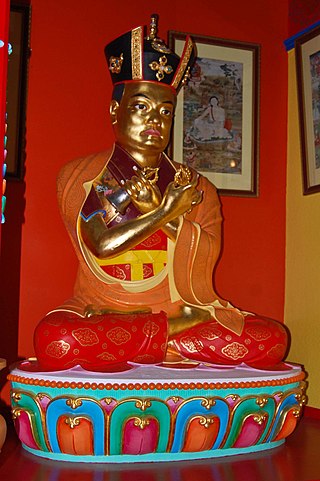
Karma Kagyu, or Kamtsang Kagyu, is a widely practiced and probably the second-largest lineage within the Kagyu school, one of the four major schools of Tibetan Buddhism. The lineage has long-standing monasteries in Tibet, China, Russia, Mongolia, India, Nepal and Bhutan, with current centres in over 60 countries. The spiritual head of the Karma Kagyu is the Gyalwa Karmapa; the 2nd among the 10 Karmapas had been the principal spiritual advisors to successive emperors of China. The Karma Kagyu are sometimes called the "Black Hat" lamas, in reference to the Black Crown worn by the Karmapa.

Jamyang Khyentse Wangpo, also known by his tertön title, Pema Ösel Dongak Lingpa, was a teacher, scholar and tertön of 19th-century Tibet. He was a leading figure in the Rimé movement.
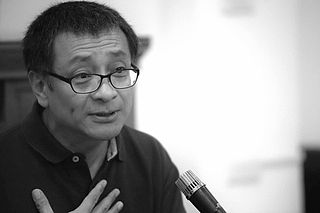
The 7th Dzogchen Ponlop is an abbot of Dzogchen Monastery, founder and spiritual director of Nalandabodhi, founder of Nītārtha Institute for Higher Buddhist Studies, a leading Tibetan Buddhist scholar, and a meditation master. He is one of the highest tülkus in the Nyingma lineage and an accomplished Karma Kagyu lineage holder.

Dzongsar Khyentse Chökyi Lodrö was a Tibetan lama, a master of many lineages, and a teacher of many of the major figures in 20th-century Tibetan Buddhism. Though he died in 1959 in Sikkim, and is not so well known in the West; he was a major proponent of the Rimé movement within Tibetan Buddhism, and had a profound influence on many of the Tibetan lamas teaching today.
Tertön is a term within Tibetan Buddhism meaning a person who is a discoverer of ancient hidden texts or terma. Many tertöns are considered to be incarnations of the twenty five main disciples of Padmasambhava, who foresaw a dark time in Tibet. He and his consort Yeshe Tsogyal hid teachings to be found in the future to benefit beings. A vast system of transmission lineages developed. Scriptures from the Nyingma school were updated by terma discoveries, and terma teachings have guided many Tibetan Bon and Buddhist practitioners.
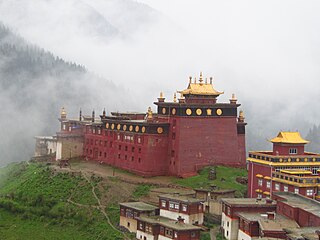
Palpung Monastery is the name of the congregation of monasteries and centers of the Tai Situpa lineage of the Kagyu school of Tibetan Buddhism as well as the name of the Tai Situ's monastic seat in Babang, Kham. Palpung means "glorious union of study and practice". It originated in the 12th century and wielded considerable religious, political, and economic influence over the centuries.

The 14th Karmapa, Theckchok Dorje (1798–1868), also Thegchog Dorje, was the 14th Gyalwa Karmapa, head of the Kagyu School of Tibetan Buddhism. Theckchok Dorje was born in Danang, Kham, Tibet, and was recognized by Drukchen Kunzig Chokyi Nangwa based on the instructional letter from the 13th Karmapa, Dudul Dorje that detailed where his next reincarnation would be born. He was enthroned and ordained as a monk by the 9th Tai Situpa Rinpoche, at the age of nineteen.

Pema Dönyö Nyinje is the 12th Tai Situpa, a tulku in Tibetan Buddhism, and one of the leading figures of the Karma Kagyu school. He is the head of Palpung Monastery.
The Profound Inner Principles also known as Profound Inner Meaning or 'Zabmo Nangdon' is a 14th century treatise and major work of Rangjung Dorje (1284–1339), the third Karmapa, born to a Nyingma family he received the full transmission of the Nyingma tradition, in addition to the Karma Kagyu.

Nyoshül Khenpo Rinpoche, more fully Nyoshül Khenpo Jamyang Dorje, was a Tibetan lama born in the Derge region of Kham.

Urgyen Tsomo (1897–1961) was a prominent Tibetan Buddhist female master who was known as the Great Dakini of Tsurphu. She was the consort of the Khakyab Dorje, 15th Karmapa Lama. She was considered by other masters to be the reincarnation (emanation) of Yeshe Tsogyal, the consort of Padmasambhava of the 8th century, who spread Buddhism in Tibet.
















